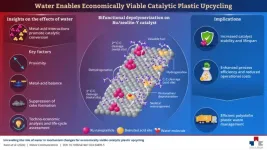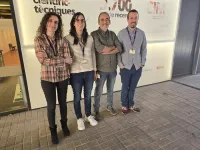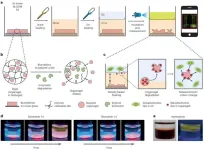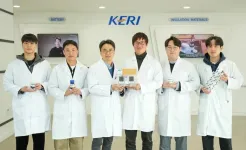(Press-News.org)
Plastics are undeniably useful materials that have found their way into virtually all human activities. However, with yearly global plastic production exceeding 400 million tons, the environmental threat posed by increased plastic consumption and disposal, contributing to its pollution, is also bigger than ever. Considering that only one-tenth of all plastic waste is recycled, new technologies that can help tackle this growing problem are urgently required.
Catalytic recycling techniques, such as hydrogenolysis and hydrocracking, are emerging chemical processes that can break down plastic waste into simpler components using catalysts. Traditional recycling involves melting and remolding plastics into lower-quality materials, whereas catalytic recycling can convert plastics into valuable chemicals and fuels, enabling a more sustainable and efficient reuse. Though certainly promising, catalytic recycling methods need further refinements before they are ready for adoption on an industrial scale.
In a recent study published in Nature Communications online on 29 November, 2024, a research team led by Professor Insoo Ro of Seoul National University of Science and Technology, Korea, recently made a breakthrough discovery in the catalytic recycling of polyolefins, which comprise 55% of global plastic waste. As explained in their article, the researchers revealed the surprising benefits of adding water during polyolefin depolymerization when using ruthenium (Ru)-based catalysts.
After synthesizing and experimenting on various Ru-based catalysts on different supports, the team found that catalysts with both metal and acid sites exhibit dramatically improved conversion rates when water is added to the reaction mixture. “The addition of water alters the reaction mechanisms, promoting pathways that enhance catalytic activity while suppressing coke formation,” explains Dr. Ro, “This dual role improves process efficiency, extends catalyst lifespan, and reduces operational costs.”
The researchers investigated the reaction mechanisms in detail, shedding light on the effect of Ru content and the proximity and balance between metal and acid sites. Under optimal conditions, Ru/zeolite-Y catalysts showcased a 96.9% conversion rate for polyolefins.
Finally, to explore the viability of this type of catalytic recycling, the team conducted a techno-economic analysis and a life cycle assessment of the proposed approach. The results clearly underscored the potential of implementing a real commercial-scale process using Ru/zeolite-Y catalyst. “The addition of water not only enhances carbon efficiency, it improves economic and environmental performance, also increases the conversion of polyolefins to valuable fuels like gasoline and diesel,” highlights Dr. Ro. Adding further, he says, “This approach thus represents a viable alternative to conventional waste management practices and offers a solution to reduce landfill and ocean pollution caused by polyolefins—the largest contributor to plastic waste.”
Overall, this breakthrough in catalytic depolymerization could revolutionize how we deal with plastic pollution and help us efficiently deal with this serious environmental threat. The research team has high hopes that this technology will evolve over the next few years to the point that mixed plastic waste can be processed without pre-sorting, making recycling efforts more cost-effective and simpler to implement. “By demonstrating a sustainable and economic approach to transforming plastic waste into valuable resources, our research could help drive policy changes, inspire investment in advanced recycling infrastructure, and foster international collaborations to address the global plastic waste crisis. Over time, these advancements promise cleaner environments, reduced pollution, and a more sustainable future,” concludes Dr. Ro on an optimistic note.
***
Reference
DOI: 10.1038/s41467-024-54495-5
About the institute Seoul National University of Science and Technology (SEOULTECH)
Seoul National University of Science and Technology, commonly known as 'SEOULTECH,' is a national university located in Nowon-gu, Seoul, South Korea. Founded in April 1910, around the time of the establishment of the Republic of Korea, SEOULTECH has grown into a large and comprehensive university with a campus size of 504,922 m2. It comprises 10 undergraduate schools, 35 departments, 6 graduate schools, and has an enrollment of approximately 14,595 students.
Website: https://en.seoultech.ac.kr/
About the author
Professor Insoo Ro earned his B.S. degree magna cum laude in Chemical Engineering from Rice University, USA, in 2012 and his Ph.D. from the University of Wisconsin-Madison, USA, in 2017 under Professor James Dumesic and Prof. George Huber. After conducting postdoctoral research at UC Santa Barbara, USA, with Prof. Phillip Christopher, he joined Seoul National University of Science and Technology, Korea, in 2020 as an Assistant Professor. He has published over 30 papers in various prestigious journals, including Nature and Nature Communications, and has received numerous awards, such as the Miwon Young Scientist Award and the Science & Technology Outstanding Paper Award.
END
Antibiotics, antivirals, vaccinations and anti-inflammatory medication are associated with reduced risk of dementia, according to new research that looked at health data from over 130 million individuals.
The study, led by researchers from the universities of Cambridge and Exeter, identified several drugs already licensed and in use that have the potential to be repurposed to treat dementia.
Dementia is a leading cause of death in the UK and can lead to profound distress in the individual and among those caring for them. It has been estimated to have a worldwide economic cost in excess of US$1 trillion dollars.
Despite intensive ...
EUGENE, Ore. — Jan. 21, 2025 — Increased exposure to glyphosate, one of the most widely used herbicides in the United States and much of the world, harms infant health in U.S. agricultural counties, according to a new study by two University of Oregon economists.
In a paper published Jan. 14 in the Proceedings of the National Academy of Sciences, Emmett Reynier and Edward Rubin showed that a dramatic increase in the use of glyphosate in U.S. counties most suitable for genetically engineered crops lowered ...
Are dogs really the key to better health and a happier life? In this new study, dog owners were invited to describe the biggest benefits and challenges of dog ownership. The commitments and responsibilities of having a dog were found to be both a joy and a burden, highlighting the importance of making a conscious adoption choice.
The pet dog population has been growing worldwide. Often benefiting from good press in mainstream media, dog ownership is generally assumed to improve human lives, providing companionship and boosting well-being. While bringing a dog into the family does come with ...
After millennia as a carbon deep-freezer for the planet, regional hotspots and increasingly frequent wildfires in the northern latitudes have nearly canceled out that critical storage capacity in the permafrost region, according to a new study published in Nature Climate Change.
An international team led by Woodwell Climate Research Center found that a third (34 percent) of the Arctic-boreal zone (ABZ)—the treeless tundra, boreal forests, and wetlands that make up Earth’s northern latitudes—is now a source of carbon to the atmosphere. That balance sheet is made up of carbon dioxide (CO₂) uptake from plant photosynthesis and CO₂ ...
A study recently published by researchers from the Sant Pau Research Institute (IR Sant Pau) and the Stroke Unit of Sant Pau Hospital in the Journal of Lipid Research provides new evidence on the essential role of the qualitative properties of lipoproteins, such as LDL and HDL, in the pathophysiology of cardiovascular diseases, including ischaemic stroke. The findings underscore the importance of going beyond traditional quantitative cholesterol levels to evaluate the risk of these pathologies.
Dr ...
Bladder cancer has a cure rate of over 90% when detected early, but it has a high recurrence rate of 70%, necessitating continuous monitoring. Late detection often requires major surgeries such as bladder removal followed by artificial bladder implantation or the use of a urine pouch, significantly lowering the patient’s quality of life. However, existing urine test kits have low sensitivity, and cystoscopy, which involves inserting a catheter into the urethra for internal bladder examination, is both painful and burdensome. This highlights the urgent need for a simple yet accurate diagnostic technology for patients.
The research team led by Dr. Youngdo Jeong of the Center for Advanced ...
Researchers at the Autism Research Centre at Cambridge University found that these individuals also report experiencing lower quality healthcare than both autistic and non-autistic people whose gender identity matches their sex assigned at birth (cisgender).
The findings have important implications for the healthcare and support of autistic transgender/gender diverse (TGD) individuals. This is the first large-scale study on the experiences of autistic TGD people and the results are published today in Molecular Autism.
Previous research suggests that both autistic people and TGD people separately have poorer healthcare experiences ...
Embargoed for release until 5:00 p.m. ET on Monday 20 January 2025
@Annalsofim
Below please find summaries of new articles that will be published in the next issue of Annals of Internal Medicine. The summaries are not intended to substitute for the full articles as a source of information. This information is under strict embargo and by taking it into possession, media representatives are committing to the terms of the embargo not only on their own behalf, but also on behalf of the organization they represent. ...
Dr. Park Jun-woo's team at KERI's Next Generation Battery Research Center has overcome a major obstacle to the commercialization of next-generation lithium–sulfur batteries and successfully developed large-area, high-capacity prototypes.
The lithium–sulfur battery, composed of sulfur as the cathode (+) and lithium metal as the anode (-), has a theoretical energy density more than eight times that of lithium-ion batteries, demonstrating significant potential. Additionally, it uses abundant sulfur (S) instead of expensive rare earth elements, making it cost-effective and environmentally ...
A new study reported in the Cell Press journal Current Biology on January 20 is the first to describe a phenomenon researchers refer to as “contagious urinations.” The study in 20 captive chimpanzees living at the Kumamoto Sanctuary in Japan shows that, when one chimp pees, others are more likely to follow.
“In humans, urinating together can be seen as a social phenomenon,” says Ena Onishi of Kyoto University.
“An Italian proverb states, ‘Whoever doesn’t pee in company is either a thief or a spy’ (Chi non piscia in compagnia o è ...






